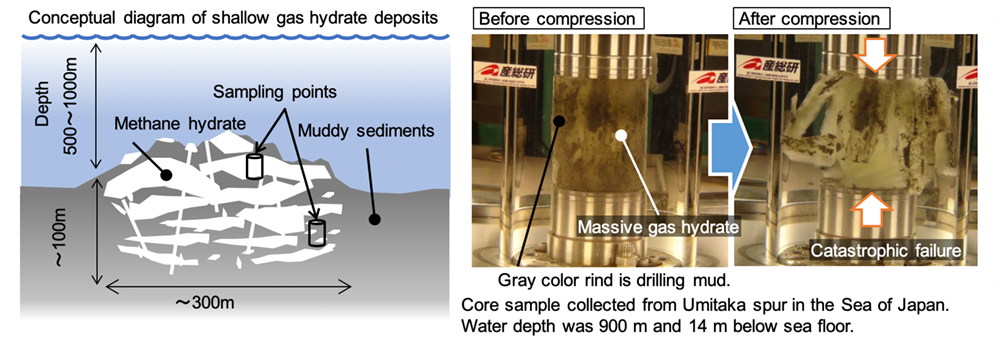World’s first success in the measurement of the mechanical properties of deep-sea methane hydrates
- The information crucial for developing and evaluating their recovery techniques -
Summary of AIST Press Release November 28, 2019
>>Japanese
Methane hydrates are a prospective energy resource which widely occurs in ocean floor sediments and in permafrost. As they are unstable under atmospheric pressure and ordinary temperature decomposing into methane and water, it has been very difficult to measure their in-situ mechanical properties, which is needed for developing their recovery techniques. The researchers of the Research Institute of Energy Frontier (RIEF) and the Geological Survey of Japan (GSJ), AIST, conducted uniaxial and triaxial compression tests of natural gas hydrate core samples, and succeeded in measuring their strength and stiffness. These core samples were collected from a shallow gas hydrate deposit maintaining them at high pressure and low temperature in the collaborative research of AIST and Meiji University. In the experiment, massive natural gas hydrates showed catastrophic brittle failure, which indicates much weaker strength (approximately 1/200 of its single crystal). This strength is equivalent to that of polycrystalline ice under atmospheric pressure at −10 °C. The strength and stiffness of muddy sediments containing hydrate nodules are almost the same as those of hydrate-free sediments collected from the same regions. This measurement technique is expected to be a great contribution to the development of deep-sea resources and environmental assessment because information is critical for examining recovery techniques and/or assessing the mechanical stability of ocean floor.
This study was published on December 4, 2019 as below:
Yoneda, J., Kida, M., Konno, Y., Jin, Y., Morita, S., & Tenma, N. (2019). In situ mechanical properties of shallow gas hydrate deposits in the deep seabed. Geophysical Research Letters, 46, 1-10.
Fig. 1. Image of shallow gas hydrate deposits (left) and photos of triaxial compression tests (right).


